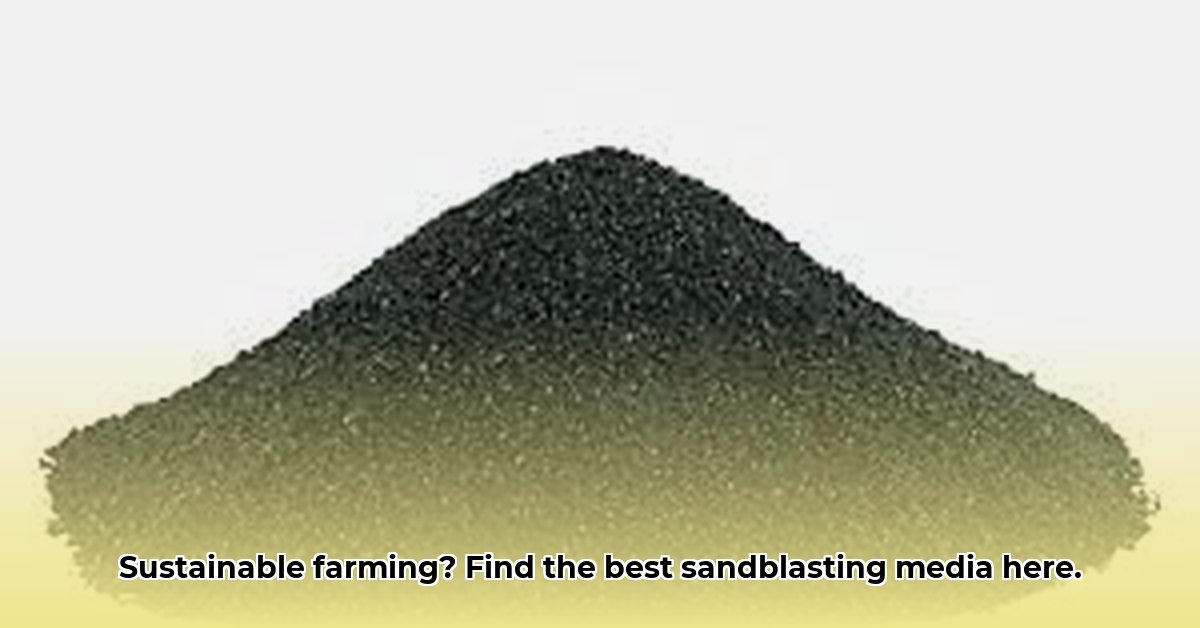
Understanding Sandblasting Media in Agriculture
Sandblasting (abrasive blasting) uses a high-velocity stream of abrasive material to clean or prepare surfaces. While traditionally associated with industrial applications, carefully chosen sandblasting media offers potential benefits for sustainable agriculture. This guide explores various media types, selection criteria, and safe usage practices, specifically focusing on their potential (though currently limited) role in sustainable farming. For more information on farm equipment maintenance, check out these rototiller options.
Exploring Sandblasting Media Options for Eco-Conscious Farming
The "sand" in sandblasting can encompass a wide range of materials, each with different environmental impacts and suitability for various agricultural applications.
Glass Beads
Glass beads are relatively soft, providing a smooth finish without excessive surface damage. Their reusability minimizes waste. However, glass bead manufacturing consumes energy, so their environmental impact isn't negligible.
Walnut Shells
A biodegradable and readily available option, walnut shells represent a more environmentally friendly alternative. Their moderate abrasiveness suits many cleaning tasks. However, proper disposal is still necessary after use.
Other Media: Corn Cobs, Plastic, Steel Grit
Several other options exist, including corn cobs (biodegradable and low-abrasive), plastic beads (variable abrasiveness, but non-biodegradable), and steel grit (highly abrasive, but potentially causing rust). The environmental impact and suitability for agricultural applications vary greatly.
Media Comparison Table
| Media Type | Abrasiveness | Reusability | Biodegradable | Environmental Impact | Cost | Application Examples |
|---|---|---|---|---|---|---|
| Glass Beads | Low | High | No | Moderate (manufacturing) | Moderate | Cleaning delicate equipment, fine finishing |
| Walnut Shells | Moderate | Low | Yes | Low | Moderate | General cleaning, removing moderate grime |
| Corn Cob Media | Very Low | Low | Yes | Very Low | Moderate | Gentle cleaning, delicate surfaces |
| Plastic Media | Variable | Moderate | No | High (non-biodegradable) | Low | (Use cautiously; consider environmental impact) |
| Steel Grit | High | Low | No | Moderate (rust potential) | High | Heavy-duty cleaning, removing extremely tough layers |
Note: Cost and environmental impact can vary based on manufacturer and sourcing.
Selecting the Right Sandblasting Media: A Practical Guide
Choosing the appropriate media involves a multi-faceted decision-making process:
Assess the Surface: Delicate equipment requires gentler media (e.g., walnut shells or corn cobs) than heavily corroded surfaces (e.g., steel grit).
Specify Desired Finish: A smooth finish calls for less abrasive media; a rougher texture is acceptable with more abrasive options.
Prioritize Sustainability: Biodegradable options (walnut shells, corn cobs) reduce environmental impact. Reusability (glass beads) also minimizes waste.
Consider Cost-Effectiveness: Balance the initial media cost with reusability and performance.
Check Local Availability: Inquire at your local Tractor Supply or equivalent retailer for available options and pricing.
Sandblasting Safety: Essential Precautions
Sandblasting poses safety risks. Always:
- Wear a respirator: Prevent inhaling abrasive dust.
- Protect your eyes: Use safety glasses or a face shield.
- Wear protective gloves and clothing: Prevent skin irritation and injury.
- Work in a well-ventilated area: Minimize dust accumulation.
- Consult the Safety Data Sheet (SDS): Obtain detailed safety instructions for your chosen media.
Sandblasting in Sustainable Agriculture: Current and Potential Applications
Currently, sandblasting's adoption in sustainable agriculture remains limited. However, potential applications exist:
Equipment Maintenance: Removing dirt, rust, and other build-up extends equipment lifespan and reduces the need for replacements.
Surface Preparation: Preparing surfaces for bio-based coatings could enhance the durability and eco-friendliness of farm equipment.
Solar Panel Cleaning: Maintaining clean solar panels on farms optimizes energy production.
Further research is needed to fully validate the efficacy and long-term environmental impact of these applications.
Conclusion: Responsible Sandblasting for Sustainable Farming
Sandblasting can offer benefits for sustainable agriculture, but responsible media selection is crucial. By carefully considering the factors outlined above – prioritizing biodegradable and reusable options and adhering to safety protocols – farmers can leverage this technology while minimizing their environmental footprint. Further research and development will likely expand the practical applications of sandblasting within sustainable agricultural practices.